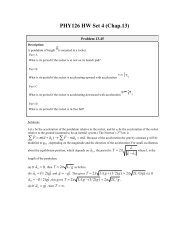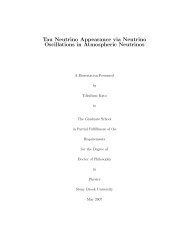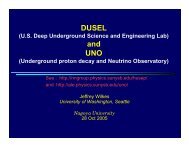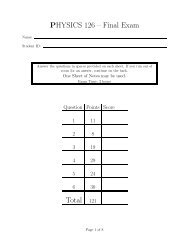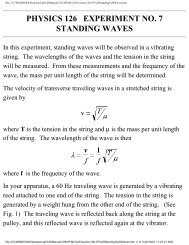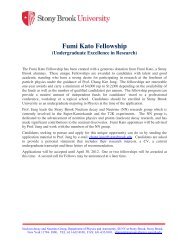Measuring the Gravitational Acceleration with a Pendulum Procedure
Measuring the Gravitational Acceleration with a Pendulum Procedure
Measuring the Gravitational Acceleration with a Pendulum Procedure
Create successful ePaper yourself
Turn your PDF publications into a flip-book with our unique Google optimized e-Paper software.
Page 1 of 2 − Measurement of <strong>the</strong> <strong>Gravitational</strong> <strong>Acceleration</strong> using a <strong>Pendulum</strong><br />
<strong>Measuring</strong> <strong>the</strong> <strong>Gravitational</strong> <strong>Acceleration</strong> <strong>with</strong> a <strong>Pendulum</strong><br />
In this lab you will measure <strong>the</strong> gravitational acceleration using a simple pendulum. For <strong>the</strong> purposes<br />
of this lab, <strong>the</strong> simple pendulum is modeled as a simple harmonic oscillator, but <strong>with</strong> <strong>the</strong> caveat that<br />
this only applies under small oscillations. This model predicts that <strong>the</strong> period <strong>the</strong> pendulum is<br />
√<br />
independent of <strong>the</strong> amplitude of oscillation, and that <strong>the</strong> period is T =2π L g<br />
of <strong>the</strong> string, g is <strong>the</strong> gravitational acceleration, and T is <strong>the</strong> period.<br />
Equipment<br />
where L is <strong>the</strong> length<br />
A simple pendulum, a meter stick, a protractor, a stopwatch or o<strong>the</strong>r timer (0.1 second or better<br />
precision).<br />
<strong>Procedure</strong><br />
This lab has three parts. The first two parts verify <strong>the</strong> accuracy of <strong>the</strong> model for <strong>the</strong> simple pendulum.<br />
The final part measures <strong>the</strong> gravitational acceleration.<br />
Verify <strong>the</strong> relationship between period and amplitude.<br />
The “simple harmonic oscillator” model of simple pendulum predicts that for small oscillations, <strong>the</strong><br />
period is independent of <strong>the</strong> amplitude. The first step in this lab is to investigate <strong>the</strong> range of<br />
amplitudes over which <strong>the</strong> small angle approximation is valid. This can be done by measuring <strong>the</strong><br />
period for a variety of amplitudes and determining <strong>the</strong> range over which <strong>the</strong> amplitude does not change.<br />
1 Adjust <strong>the</strong> length of <strong>the</strong> string so that it is about 50 cm. long.<br />
2 Using <strong>the</strong> stop watch, measure <strong>the</strong> period for several amplitudes (e.g. 5°, 10°, 15°, 30°, 60°)<br />
2.1 Use <strong>the</strong> protractor to start <strong>the</strong> oscillation at a particular amplitude.<br />
2.2 Determine <strong>the</strong> period by measuring <strong>the</strong> time for <strong>the</strong> pendulum to go through at least<br />
ten cycles.<br />
3 Plot <strong>the</strong> period as a function of <strong>the</strong> amplitude.<br />
3.1 Does <strong>the</strong> period vary as a function of amplitude How much<br />
3.2 Over what range of angle is <strong>the</strong> small angle approximation valid<br />
Verify <strong>the</strong> relationship between length and period.<br />
The simple pendulum model predicts that <strong>the</strong> period squared, T 2 , is linearly proportional to <strong>the</strong> length<br />
of <strong>the</strong> string, so <strong>the</strong> second step in this lab is to verify this prediction. This can be done by measuring<br />
<strong>the</strong> period (for a small amplitude) for various string lengths and checking that <strong>the</strong> predicted relationship<br />
is correct.<br />
1 Using <strong>the</strong> stop watch, measure <strong>the</strong> period for several different string lengths (e.g. about 20 cm,<br />
30 cm, 40 cm, 50 cm, and 60 cm). Be sure that you measure <strong>the</strong> length of <strong>the</strong> string from <strong>the</strong>
Page 2 of 2 − Measurement of <strong>the</strong> <strong>Gravitational</strong> <strong>Acceleration</strong> using a <strong>Pendulum</strong><br />
top attachment point to <strong>the</strong> center of <strong>the</strong> mass.<br />
1.1 Use your results from <strong>the</strong> previous step to choose an appropriate amplitude.<br />
1.2 Determine <strong>the</strong> period by measuring <strong>the</strong> time for <strong>the</strong> pendulum to go through at least<br />
ten cycles.<br />
2 Plot <strong>the</strong> period squared, T 2 , as a function of <strong>the</strong> string length, L.<br />
2.1 Is <strong>the</strong> square of <strong>the</strong> period linearly proportional to <strong>the</strong> length of <strong>the</strong> string<br />
Measure <strong>the</strong> acceleration due to gravity.<br />
The final step is to determine <strong>the</strong> acceleration due to gravity. Before doing that, you should consider<br />
how to get <strong>the</strong> most accurate measurement. There are three factors you must consider:<br />
1 How accurately can you measure <strong>the</strong> period<br />
1.1 To get an accurate measurement of <strong>the</strong> period, you should measure <strong>the</strong> pendulum for<br />
at least 100 seconds and 50 cycles (which ever takes longer).<br />
1.2 What is <strong>the</strong> uncertainty on <strong>the</strong> measured time (σ T )<br />
1.2.1 The fractional uncertainty is defined as σ T /T. What is <strong>the</strong> fractional uncertainty<br />
2 How accurately can you measure <strong>the</strong> length of <strong>the</strong> string<br />
2.1 Choose an appropriate length for <strong>the</strong> string. You should choose a length that is long<br />
enough to measure accurately.<br />
2.2 Measure how long you have made <strong>the</strong> string.<br />
2.3 What is <strong>the</strong> uncertainty on <strong>the</strong> measured length of <strong>the</strong> string (σ L )<br />
2.3.1 The fractional uncertainty is defined as σ L /L. What is <strong>the</strong> fractional uncertainty<br />
3 How valid is <strong>the</strong> small angle approximation used in <strong>the</strong> model of <strong>the</strong> simple pendulum<br />
3.1 Choose an appropriate starting amplitude.<br />
4 Measure <strong>the</strong> period of <strong>the</strong> pendulum.<br />
The acceleration due to gravity is <strong>the</strong>n found using g =4 π 2 L T 2 and <strong>the</strong> estimated fractional<br />
uncertainty on <strong>the</strong> gravitational acceleration is equal to<br />
<strong>the</strong> estimated uncertainty of your measurement.<br />
1. What is your measured value for “g”<br />
σ g<br />
g = √( σ L<br />
L ) 2 +4 (<br />
σ T<br />
T ) 2<br />
2. What is <strong>the</strong> fractional uncertainty for your measurement of “g”<br />
3. How could you have improved your measurement<br />
so you can determine



